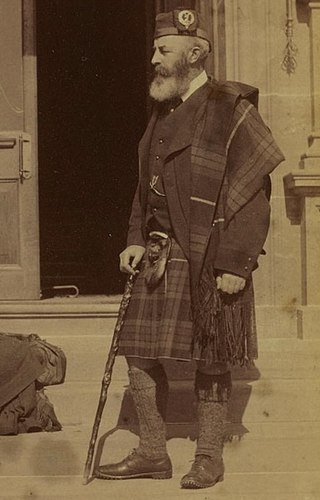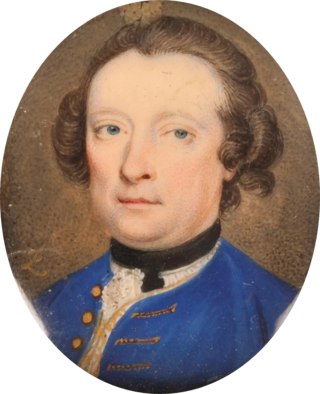Related Research Articles

Selkirkshire or the County of Selkirk is a historic county and registration county of Scotland. It borders Peeblesshire to the west, Midlothian to the north, Roxburghshire to the east, and Dumfriesshire to the south. It derives its name from its county town, the royal burgh of Selkirk. The county was historically also known as Ettrick Forest.

Clan Douglas is an ancient clan or noble house from the Scottish Lowlands.

Simon Fraser, 13th Lord Lovat and 2nd Baron Lovat was a British nobleman and soldier. He was responsible for overseeing the reconstruction of Beaufort Castle, and was the 22nd Chief of Clan Fraser of Lovat.
John Murray was a Scottish lawyer and politician.
John St Clair, Master of Sinclair was a Scottish Army officer and Tory politician who sat briefly in the British House of Commons in 1708 before he was excluded as ineligible as eldest son of a Scottish peer. He was court-martialled and under sentence of death for the killing of two fellow officers before he escaped to serve in the Prussian army and was subsequently pardoned. He then took part as a rebel in the Jacobite Rebellion of 1715 and was attainted and excluded in succession to his father's property. He returned to Scotland after ten years abroad.
Sir Samuel Barber Strang Steel of Philiphaugh, 1st Baronet, Territorial Decoration was a landowner and Conservative Party politician in the United Kingdom. He was Member of Parliament (MP) for Ashford from 1918 to 1929.
William Douglas, 1st Marquess of Douglas and 11th Earl of Angus (1589–1660) was a Scottish nobleman.
Walter Campbell, 3rd of Shawfield and Islay and 9th of Skipness was a Scottish landowner, advocate and Rector of Glasgow University.
John Murray, of Philiphaugh, Selkirk, was a British politician who was the Member of Parliament for the Lanark Burghs, between 9 May 1754 and 20 April 1761.
Sir Robert Murray of Cameron was a Scottish politician.

Sir James Murray, Lord Philiphaugh PC was a Scottish judge and politician who twice served as Lord Clerk Register from November 1702 to June 1704 and from April 1705 to July 1708, when he died in office. Serving as a political advisor to the prominent statesman James Douglas, 2nd Duke of Queensberry, Murray assisted him in passing the 1707 Union with England Act through a divided Parliament of Scotland.

Sir William Owen, 4th Baronet (1697?–1781), of Orielton, Pembrokeshire, was a Welsh politician who sat in the House of Commons for 52 years from 1722 to 1774.
Before the Acts of Union 1707, the barons of the shire of Selkirk elected commissioners to represent them in the unicameral Parliament of Scotland and in the Convention of the Estates.
John Pringle, Lord Haining was a Scottish lawyer, politician, and judge. His ownership of a large estate near Selkirk secured him a seat in the Parliament of Scotland from 1702 until the Act of Union in 1707, and then in the House of Commons of Great Britain from 1707 until he became a Lord of Session in 1729.

John Pringle (c.1716-1792), was a Scottish merchant and politician who sat in the House of Commons between 1765 and 1786.
Sir Robert Pollock, 1st Baronet, of Pollok, was a British Army officer and Scottish politician who sat in the Parliament of Scotland from 1700 to 1707 and in the British House of Commons from 1707 to 1722.
James Rutherford of Bowland, Midlothian was a Scottish politician who sat in the House of Commons from 1730 to 1733.

Sir John Douglas, 3rd Baronet came from a junior branch of the Douglas family and was related to the Dukes of Queensberry. In 1741, he was elected Member of Parliament for Dumfriesshire, a borough controlled by the Queensberry interest.
Basil Hamilton was a Scottish Jacobite.
Lord Basil Hamilton was a Scottish aristocrat who drowned trying to save his servant.
References
- 1 2 3 4 5 6 "MURRAY, John (d.1753), of Philiphaugh, Selkirk". History of Parliament Online . Retrieved 27 February 2013.
- ↑ Mann, A. J. (2004). "Murray, Sir James, Lord Philiphaugh (1655-1708)" . Oxford Dictionary of National Biography (online ed.). Oxford University Press. doi:10.1093/ref:odnb/19615.(Subscription or UK public library membership required.)
- ↑ Paul, James Balfour (1910). The Scots Peerage: Founded on Wood's Edition of Sir Robert Douglas's Peerage of Scotland; Containing an Historical and Genealogical Account of the Nobility of that Kingdom. D. Douglas. p. 518. Retrieved 4 November 2022.
- 1 2 3 4 5 6 7 8 9 10 Burke, John (1838). A Genealogical and Heraldic History of the Landed Gentry; Or, Commoners of Great Britain and Ireland Etc. Henry Colburn. p. 59. Retrieved 4 November 2022.